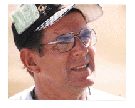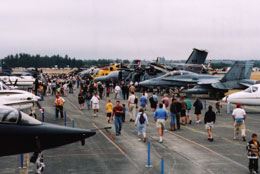The
Abbotsford International Air Show
by
Ed Anderson
 Abbotsford
British Columbia, home of the Abbotsford International
Airshow, hosted the 41st edition of the big show 8, 9, 10
of August 2003. Celebrating the 100th Anniversary of
Powered Flight, gates were open to the general public at
8:00 am. The huge static ramp welcomed visitors at 8:30,
with light flying events at 10:30, and the main air
program at 11:30. Opening Ceremonies followed at noon or
thereabouts. The days events ended at 5 pm. and gates
were closed to patrons at 6 pm. Ten hours - enough for
anyone's venue in one day, even the most avid of airshow
fans and aviation
enthusiasts.
Regardless
of being somewhat of a weather challenged show this year
- some cooker heat, clear blue high sky, clouds, showers,
humidity, haze and peek-a-boo sun stuff - the gate
numbers were reported to be better than expected,
apparently exceeding last years 3 day total of 160,000 by
an estimated 20 percent. An encouraging continued
increase since the lost year of 1998. Although the days
of old may yet be a ways off, the come-back trail appears
pretty darn positive nonetheless.
Abbotsford
British Columbia, home of the Abbotsford International
Airshow, hosted the 41st edition of the big show 8, 9, 10
of August 2003. Celebrating the 100th Anniversary of
Powered Flight, gates were open to the general public at
8:00 am. The huge static ramp welcomed visitors at 8:30,
with light flying events at 10:30, and the main air
program at 11:30. Opening Ceremonies followed at noon or
thereabouts. The days events ended at 5 pm. and gates
were closed to patrons at 6 pm. Ten hours - enough for
anyone's venue in one day, even the most avid of airshow
fans and aviation
enthusiasts.
Regardless
of being somewhat of a weather challenged show this year
- some cooker heat, clear blue high sky, clouds, showers,
humidity, haze and peek-a-boo sun stuff - the gate
numbers were reported to be better than expected,
apparently exceeding last years 3 day total of 160,000 by
an estimated 20 percent. An encouraging continued
increase since the lost year of 1998. Although the days
of old may yet be a ways off, the come-back trail appears
pretty darn positive nonetheless.
Abbotsford is less than an hour's drive east of
Vancouver, BC on the main Trans Canada Highway. It is in
the heart of the fertile Fraser Valley and a major
agricultural centre. The airport has undergone phenomenal
growth in traffic and has earned international
status.
 Despite
several 'last minute' cancellations of U.S. military
aircraft, including the "Blue Angels"/ Marines C-130 "Fat
Albert" due to an apparent mechanical problem, there were
still plenty of arrivals for static display, especially
the fighter and ground support types. A crowd favorite
and farmers headache, the B1-B "Lancer" bomber was a no
show as were the KC-10 "Extender" refuel tanker, and the
C-17 Globemaster III airlifter. Evidently 'tending' to
more important business elsewhere in the world, one would
guess. An interesting footnote though, is that this years
attending C-5A heavy lifter 68304, AFRC, Westover, is the
first "Galaxy" to be retired by the United States Air
Force, supposedly in February, 2004. However, 2003 also
featured the Abbotsford Airshow premier of the all new
Lockheed Martin C-130J "Super Hercules" - the world's
most advanced military airlifter. "Not your father's
Hercules!" according to a recent quip by an excited USAF
operator. A fresh and completely re-engineered C-130
Hercules transporter, which flies 40% further, faster and
with less fuel than earlier versions, and handled by only
a crew of three - left seat, right seat and loadmaster.
The C-130J is said to usher in a new era in air mobility
and is currently in production for military forces and
Homeland Defense of the United States, Britain,
Australia, Italy and Denmark. For further details check
website www.lockheedmartin.com
Despite
several 'last minute' cancellations of U.S. military
aircraft, including the "Blue Angels"/ Marines C-130 "Fat
Albert" due to an apparent mechanical problem, there were
still plenty of arrivals for static display, especially
the fighter and ground support types. A crowd favorite
and farmers headache, the B1-B "Lancer" bomber was a no
show as were the KC-10 "Extender" refuel tanker, and the
C-17 Globemaster III airlifter. Evidently 'tending' to
more important business elsewhere in the world, one would
guess. An interesting footnote though, is that this years
attending C-5A heavy lifter 68304, AFRC, Westover, is the
first "Galaxy" to be retired by the United States Air
Force, supposedly in February, 2004. However, 2003 also
featured the Abbotsford Airshow premier of the all new
Lockheed Martin C-130J "Super Hercules" - the world's
most advanced military airlifter. "Not your father's
Hercules!" according to a recent quip by an excited USAF
operator. A fresh and completely re-engineered C-130
Hercules transporter, which flies 40% further, faster and
with less fuel than earlier versions, and handled by only
a crew of three - left seat, right seat and loadmaster.
The C-130J is said to usher in a new era in air mobility
and is currently in production for military forces and
Homeland Defense of the United States, Britain,
Australia, Italy and Denmark. For further details check
website www.lockheedmartin.com
Ground
displays & attractions were plentiful as were vendors
of all sorts. This year though held a new look and
variety of food and drink concessions, monitored by a
ticket purchase system rather than by payment of cash at
each stand. Change is good, some say.
Well
rounded and entertaining announcers make for essential
ingredients of a smooth and successful airshow program.
The Abbotsford Airshow is indeed fortunate to have two of
the best in the business. Bob Singleton, veteran airshow
narrator and his fun loving side-kick Roy Hafeli, an
accomplished air display and special events announcer in
his own right, both local guys, did a fabulous job of
keeping the show on track, despite fluctuating weather
conditions and inherent flying schedule adjustments.
Always the consummate professionals, even when reminding
those who should, by common sense, know better than to
light up cigarettes on dry grass areas, let alone around
fuel venting aircraft.
19
Wing Comox, B.C. and 4 Wing Cold Lake, AB were likewise
well represented with both ramp display aircraft and 'Hot
Line' performers. A CT-156 Harvard II, based at Moose Jaw
SK made it's inaugural visit to Abbotsford, giving the
aviation minded a first-hand look at the Canadian/Nato
version of the United States T-6A, "Texan 2" produced by
Raytheon Aircraft Co., an example of which was on show
display last year.
The
United States Navy "Blue Angels" and Canadian Forces
"Snowbirds" jet formation and aerobatic teams were this
year's premier performers. The "Blue Angels", formed in
mid 1946 and the "Snowbirds" first performing in 1971,
although equally impressive in their respective air
display regimens, are completely different in every other
aspect. Perhaps this is why the American and Canadian
teams are such an interesting and entertaining contrast,
which also serves to compliment one another and their
distinct styles of aerobatic routines, brought about
mainly because of the types of aircraft they fly. The
"Blues" six plane unit use, with great ability, the fast,
powerful and thunderous F/A-18 Hornet fighter, primarily
in variables of four formation aircraft and two solos.
The single seat Hornet version is a 56,000 lb max. weight
takeoff, 1.7 mach airplane, powered by two General
Electric F404-GE-400 turbofan engines, each capable of
pushing out 16,000 lbs of thrust. The nine-plane
"Snowbirds" team on the other hand, fly the venerable 2
seat, 7,170 lb (approx.), 412 knot airspeed, CT-114 Tutor
pilot trainer, powered by a single General Electric J-85
Can 40 engine producing just 2,700 lbs of thrust. The
dexterous aerial ballet style "Snowbirds", for the most
part operate in the nine, seven and five plane variables,
with breakaway doubles and solos. This year the "Blue
Angels", which can transition the Hornet to active duty
within hours of deployment, are scheduled to perform
nearly 70 air shows at 34 locations in the United States
and Canada. The Canadian Forces "Snowbirds" 431 Air
Demonstration Squadron performed a special Centennial of
Flight show at Abbotsford, as part of the '100 Towns for
100 Years national tour', in celebration of the 100th
Anniversary of Powered Flight. Moreover, the "Snowbirds"
in their 33rd season will perform 65 shows at 41
locations across North America in 2003.
Other
flying acts included: The Canadian Museum of Flight at
Langley, B.C. and some of their pristine aircraft
consisting of biplanes, an SE-5 replica, a Fleet Finch, a
de Havilland DH 82 Tiger Moth, a Waco F series, an award
winner Cabin Waco, AQC6, plus a low wing Mk IV Harvard,
in singles and formation fly pasts, Horizon Aero-Sports
Parachute Demo, 19 Wing Comox CH-149 "Cormorant"
Transport and Rescue Demo (now 5 examples on active duty
at Station Comox), Bud and Ross Granley displaying their
pilot skills and showmanship in the Fouga V tail Trainer,
"Golden Hawk" Harvard (SNJ actually), and the Yaks, 18T
and 55M. The effervescent and much accomplished Julie
Clark was back and performed the ever graceful musically
choreographed aerial ballet in her Mopar Parts sponsored
Beech T-34. Kent Pietsch and his extraordinary comedic
flying and dead stick routines in his Interstate Cadet
caused plenty of aahs and laughter from onlookers. Eddie
Andreini, a 35 year airshow veteran flew solo routines in
his 450 hp 'Super Stearman' and an all-red Russian Yak-9U
called "Barbarossa". "The King of Sailplane Aerobatics"
Manfred Radius again beautifully presented his Salto H
101 silent aerobatics - the man is a master. Although
there were no commercial airliner or military jet
fly-byes, at least on Friday or Saturday, Hellijet
Airways put on an impressive exhibition of their Sikorsky
76 Spirit Helicopter. Several 'Warbirds' also went
airborne bringing back to us all a piece of history with
their solo and formation fly pasts. The "Heritage
Flights" were back. Major General William Anders
(retired) flying "Val-Halla", a P-51D Mustang in element
formation with an F-15C Eagle of the United States Air
Force piloted by Captain Lendy Renegar. The Canada
Heritage Flight comprised a Mk IV Harvard, from the
Museum of Flight at Langley B.C. flown by George Kirby
son, and a CF-18 Hornet with Captain Travis Brassington
at the controls.
Military
Tactical and Multi-Role Fighter Demonstrations were
provided by a U.S. Navy F-14 "Tomcat", a U.S.A.F. F15
"Eagle" and a Canadian Forces CF-18 "Hornet". Regardless
of the day and weather these guys really rattled God's
rafters and the crowds loved it. The "Tomcat" handled by
Lieutenants Andy "Stik" Mrstik, pilot, and Courtney
"Disco" Kinnan, Rio, both of Naval Air Station Oceana,
Virginia, let it all go with this Mach 2 + Carrier-based
multi-role strike fighter, the longest service time
fighter in the U.S. Navy. Not to be outdone, Capt. Lendy
"Alamo" Renegar, a West Coast Demo Team Pilot, likewise
well demonstrated the capabilities of his mount, an F-15
Eagle, but he too, within certain boundaries of course,
lest there be square eggs, curdled milk and frayed nerves
for a few days, plus a few other things thrown in for
good measure no doubt. A 'Tiger in the Sky' was the
'Canuck' contribution and contribute he did. Captain
Travis "Brass" Brassington of 410 Tactical (Operational
Training) Squadron, Cold Lake, Alberta, driving the CF-18
Hornet dressed in a tiger motif paint scheme, in
recognition of the 'Tiger Meet of the Americas' to be
hosted at 4 Wing Cold Lake this September, put on a super
display of colorful flying both as a solo act and the
'Heritage Flight'.
Overall,
a heck of a show and the continuing addition of piston
engine war birds is a most welcome change of pace and
time.
Story
and Photos
By Ed
Anderson

